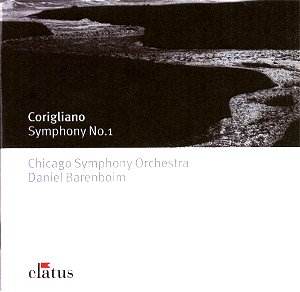Although unquestionably symphonic in its overall conception,
John Corigliano could equally have named his First Symphony,
‘Requiem Without Voices’, for in essence the work amounts to a large
scale, four-movement orchestral requiem for the numerous friends and
musical colleagues the composer has lost as a result of AIDS.
That Corigliano wears his heart on his sleeve is apparent
from the very outset, for he approaches what for many would be a truly
daunting task with a head-on fearlessness. He is equally open and lucid
in his own booklet notes on the work, which are both detailed and informative
and I would strongly recommend reading them thoroughly before listening
to the symphony for the first time. I found the insight they gave invaluable.
In many ways it is the first movement, Apologue:
of rage and remembrance, which encapsulates the emotional pendulum
of both despair and nostalgia that is at the very core of the work.
This is a movement of conflict, plunging into a psychological abyss,
yet then sweeping away on a wave of flickering memories. The opening
note of A in the violins and violas is crucially central to the work
and recurs at various points throughout the symphony although the most
extraordinary feature of the movement is Corigliano’s use of Leopold
Godowsky’s transcription of Isaac Albéniz’s Tango, a favourite
piece of the late concert pianist friend who was in Corigliano’s mind
whilst composing. The theme is used both literally as well as influencing
the melodic material of the slow central section of the movement, yet
its presence feels entirely natural, the result truly haunting.
In point of fact, the first three movements all relate
to specific lost friends, the second, Tarantella, being in memory
of a music industry executive who was also an enthusiastic amateur pianist.
The composer tells of writing a set of dances entitled Gazebo Dances
for piano, four hands, dedicating the final movement, Tarantella,
to his friend. The dictionary definition of a ‘tarantella’ is a dance
that could cure a form of insanity attributed to the bite of the tarantula,
a cutting irony as the composer’s friend was to become insane as a result
of AIDS dementia. Corigliano’s music charts a gradual descent into mental
turmoil, centred on the theme of his Tarantella, the music represents
both the horrors of the hallucinatory images his friend suffered as
well as the relief of the periods of lucidity in between. The closing
manic, screaming bars are devastatingly disturbing and left me longing
for the relative tranquillity of the third movement, Chaconne: Giulio’s
Song.
The friendship here revolves around a cellist with
whom the composer would often improvise. Listening to a tape of one
of these improvisation sessions Corigliano discovered a melodic fragment
that quite literally became the basis for "Giulio’s Song",
hence the movement makes extended use of solo cello as well as the cello
and double bass sections generally, who open the movement by introducing
the chaconne theme. The improvisation melody forms one of several "musical
remembrances" that the composer works into the music, very much
the emotional heart of the symphony, and perhaps what can be viewed
as the beautiful calm at the centre of the storm before the return of
one of the principal themes from the first movement, this time transfigured
into a funeral march.
If I have any reservations about the symphony then
it is the final Epilogue that is at the centre of them, a brief
apotheosis of the material from the previous movements including further
references to the Godowsky/Albéniz and the Tarantella
before the music fades away on the A with which the symphony commenced.
Initially I could not help but feel a curious lack of substance here
after the sheer intensity of the earlier movements although I am sure
that this was exactly the composer’s intention. Further listening will
no doubt reveal more.
My first reaction upon looking at the cover of this
CD was dismay that Warner had chosen to release a disc with just one
forty minute work when another major piece could easily have been included.
Having listened to the symphony however my opinion has changed, for
this music should stand alone exactly as it was intended, a disturbing
and very real memorial. Few recent symphonies (the work was first heard
thirteen years ago) will strike quite as directly at your heart as this
does, for Corigliano has created a work that is intensely personal and
deeply felt, but above all abundantly honest. The result, as emotionally
shattering as it is, simply cries out to be heard and Barenboim and
the Chicago Symphony Orchestra give as powerfully convincing a reading
as we are ever likely to hear. Highly recommended listening.
Christopher Thomas.

![]() Stephen Hough (piano)
John Sharp (cello)
Stephen Hough (piano)
John Sharp (cello) ![]() WARNER CLASSICS ELATUS
0927-49011-2 DDD [40:41]
WARNER CLASSICS ELATUS
0927-49011-2 DDD [40:41]